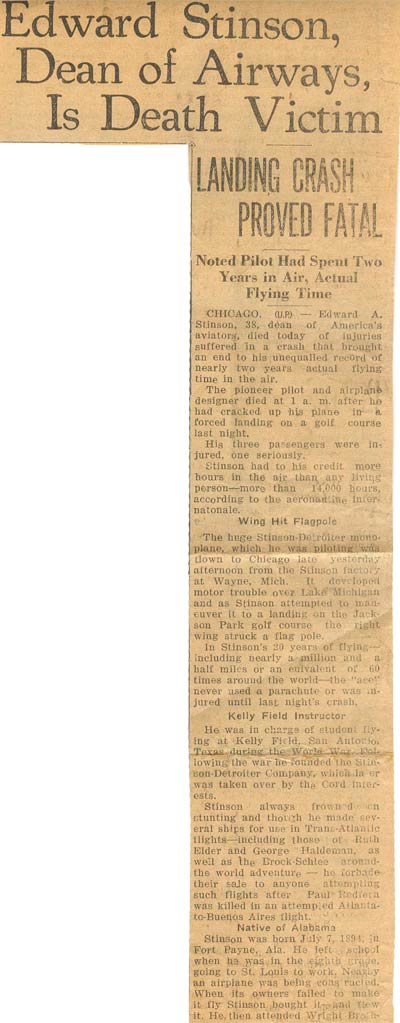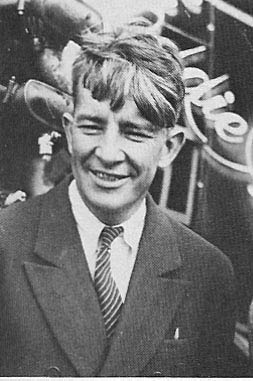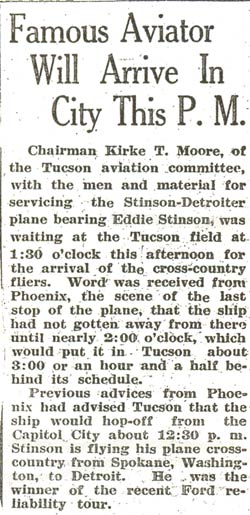|
HE WON SILVER DOLLARS ALONG THE WAY
Edward Anderson "Eddie"Stinson, Jr., was born July
11, 1894 (some say 1893, see below) at Fort Payne, Alabama.
He died as a result of an airplane crash near Chicago, Illinois,
on January 26, 1932. He made an enormous contribution to aviation
during his short life by manufacturing a line of robust and diverse aircraft bearing the Stinson name. His siblings, Catherine, Marjorie and
Jack, were also prodigious aviators of the period; Catherine
and Marjorie being among the first female aviators in the
world.
He was an instructor at Kelly Field during World War I, and
at the conclusion of the war, he founded the Detroit-Stinson
company, which later was acquired by the Cord (automobile)
corporation.
Besides sport and transport aircraft, he built the trans-Atlantic
planes of Ruth Elder and George Haldeman (both signers
of the Register), as well as the globe-circling ship of Brock
and Schlee. See this link for
similar information.
Stinson landed twice at Tucson, on October 7, 1927 and on
July 10, 1928. His 1927 flight is cited in the Tucson Citizen of the same date (see article immediately below). He logged his arrival time in the Register as 3:10PM, ten minutes behind the estimate printed in the newspaper. One of his passengers this day, Lynn Lockhart, appears in the passenger list of another Register airplane, Fokker NC535E.
His July 1928 flight was as a participant in the 1928 Ford
Reliability Tour. His airplane, a Stinson SM-1DA Detroiter,
NC5900, manufactured
June 28, 1928, was less than a month old when he landed with
it at Tucson.
The airplane was manufactured with the express intention
of being flown in the Tour. It bore race number 20 and he
noted four passengers in the Register. However the “official”
Tour information lists only two (William Baldwin and Thomas
Colby). The Forden book (reference, left) lists five passengers
(F.M. Soule, Lloyd Stone, Orval Porter, Mrs. Stinson, John
C.Day). There's no saying that passengers were not exchanged at any of the various Tour stops.
The 1928 Tour wasn't all grueling flying. The Forden book
(chapter 4) states,
| "Eddie Stinson won more silver dollars than he
could carry in the crap game that began when they all
arrived in San Francisco, a nonstop affair about which
irate wives would be lecturing for years afterward." |
At the finish line, Stinson, NC5900 and his passengers, whoever
and however many they were, placed fifth in the Tour in 1928.
They won $1,250.
All totaled, nine Stinson aircraft competed in the National
Air Tours between 1926 and 1931. There are 134 landings by
Stinson aircraft recorded between 1927 and 1936 in the Davis-Monthan
Register. This is a remarkable representation by his aircraft
brand, given that the first one manufactured rolled out of
the factory on January 25, 1926. This link
provides information on the Stinson Aircraft Company.
The following information, as well as information about Stinson
family geneology, can be found at this link.
Regarding "Balloonatic," the 14th Photo Section, 1st Army, in 1918, was called "The Balloonatic Section". The section specialized in photoreconnaissance.
| "Edward A. "Eddie" Stinson Jr.: Eddie
was born July 11, 1893, in Fort Payne, Ala. On Jan. 26,
1932, he was demonstrating a new Reliant model airplane
when he died in a plane crash at Jackson Park, Chicago,
Ill. He is buried in Holy Sepulchre Cemetery, Southfield,
Mich. He married Estelle Judy on Oct. 1, 1919, in Pittsburgh,
Pa. Estelle was born Feb. 2, 1889, in McKeesport, Pa.
She died Jan. 4, 1981, in Los Angeles, Calif. They had
no children of their own, however, Eddie did adopt Estelle's
son Raymond Judy. Raymond Judy was born in 1911 and died
April 26, 1984, in Colorado Springs, Colo. His cremains
were buried Aug. 20, 1984, in Holy Sepulchre Cemetery,
Southfield, Mich., next to his stepfather. Raymond and
his wife, Anne N., had six children. Eddie Stinson Jr.
was a World War I military pilot, Temp O-4 Balloonatic,
Wright Field, 1924 Captain, FAI license no. 375, December
1915. Stinson Field in Aberdeen, Miss., is named for him.
Stinson Aircraft Co., Wayne, Mich., (near Detroit) was
sold to Vultee Aircraft Co. after his death." |
 |
The notice of his death, right, is from an undated
1932 newsclipping from the Charles Cooper Photograph and Document Collection.
At the time of his death at age
38, Stinson had accumulated more than 16,000 hours of flight
time, more than any other pilot to date--many hundreds of
hours, on average, per year during his short life.
This article's crumbled, folded sepia newsprint leaves us
wondering what might have been if Stinson had lived and joined
the other mainstays of aircraft manufacture whose efforts
during the 1930s, during WWII and later, bring us to where
aviation technology is today. Indeed, even in his absence,
over the next three decades more than 13,000 aircraft would
carry the Stinson name.
---o0o---
Dossier 2.1.26
UPLOADED: 01/19/06 REVISED: 03/13/08, 11/30/08, 11/30/09
|




